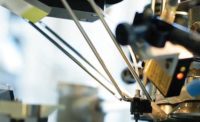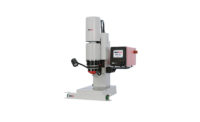Consumers spend some $1 billion to buy 2 billion lightbulbs each year in the U.S. That’s more than 6 million every day. High-speed automated assembly is the only way to meet that kind of volume.
However, the need for speed doesn’t mean that assemblers can handle bulbs in the same way they handle, say, screws or plastic caps. Glass is fragile. Indeed, the glass in a typical incandescent lightbulb is just 0.6 millimeter thick. That’s twice as thick as an eggshell, but thinner than a good wine glass.
To gently and efficiently feed glass bulbs of various shapes and sizes in an automated assembly system, one lighting manufacturer is using Dyna-Slide linear conveyors from the CDS LIPE Division of Contract Design Service Inc. in Liverpool, NY.
Dyna-Slide linear conveyors operate without belts, pulleys, rollers, chains, sprockets or other moving parts that can jam and clog. This means fewer breakdowns, increased reliability, less maintenance and greater operator safety.
The device consists of an aluminum conveyor bed lined with a special brush material. It uses a variable-speed vibrator to provide a gentle flow of parts. The brush bristles are angled, so they push the parts forward and slide back under them as the bed is rapidly vibrated, giving a finger like action to the conveyor bed.
The vibrator can be driven by compressed air, or more commonly, 115 VAC power. The vibrator is attached to the brush bed with springs. The bed and vibrator assembly is mounted to the rest of the unit with springs. The springs contribute to the proper vibratory action.
This vibratory action minimizes breakage of delicate parts and the danger of nicking, scratching or marring highly finished parts.
The brush liner is attached to the bed with Velcro strips and is easily removed for cleaning. It is made from durable, flexible polypropylene or nylon bristles that enhance feed rates by providing optimum surface contact between irregular parts and the conveying surface.
An engineered bias in the brush liner can be used to alter the linear flow of the parts without hard diverters. For example, the liner can be designed to guide parts around a corner, merge feed lanes, or circulate parts in an accumulation system. The conveyor can also incorporate additional tooling to orient and feed parts.
The technology is especially effective for part accumulation in a conveyor system where back-pressure from a driven belt would mar the underside of a part or impose nicking damage from parts impinging on one another.
Through the controller, the conveyor can move parts from slow speed to high speed to separate them, or it can go from fast speed to slow speed to accumulate parts.
Special tray configurations, such as V- or U-shaped tracks for handling cylindrical parts, are available.
The device is ideal for transferring castings between finishing operations or moving powdered metal parts, especially to transfer or accumulate green, unsintered parts from a press to the next operation.
For the lightbulb assembly application, the conveyor feeds the bulbs in a hanging orientation with the open end of the bulb down at a rate of 60 parts per minute with no breakage.
“The biggest challenge was feeding the lightbulbs without breaking them,” says Frank W. Scarson III, president of CDS LIPE. “Dyna-Slide linear parts feeders are well known for their gentle handling, adjustability, and return on investment because they can be configured for a wide range of parts.”
For more information on parts feeding and linear transfer systems, call CDS LIPE at 585-254-0050 or visit www.cds-lipe.com.



